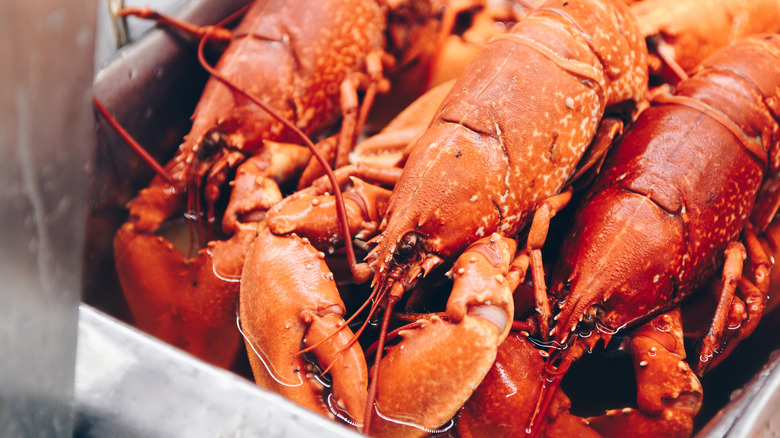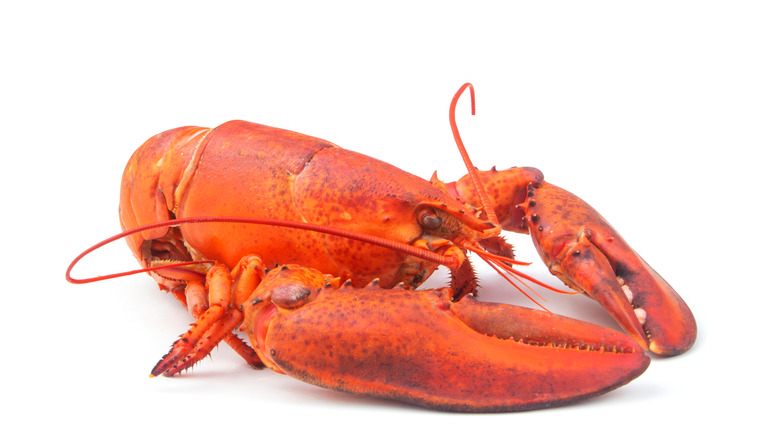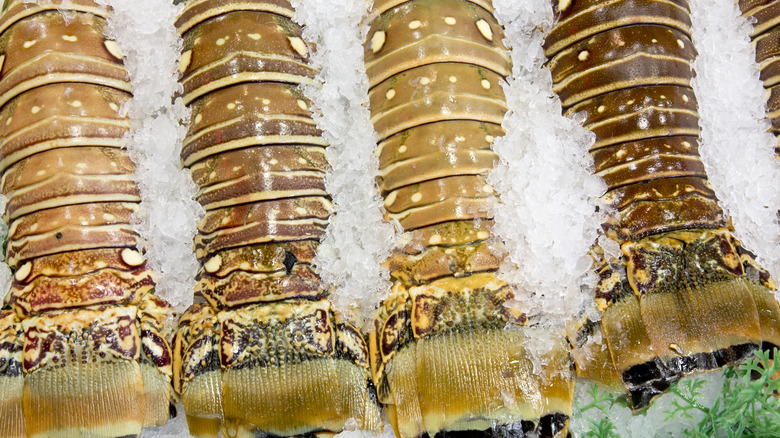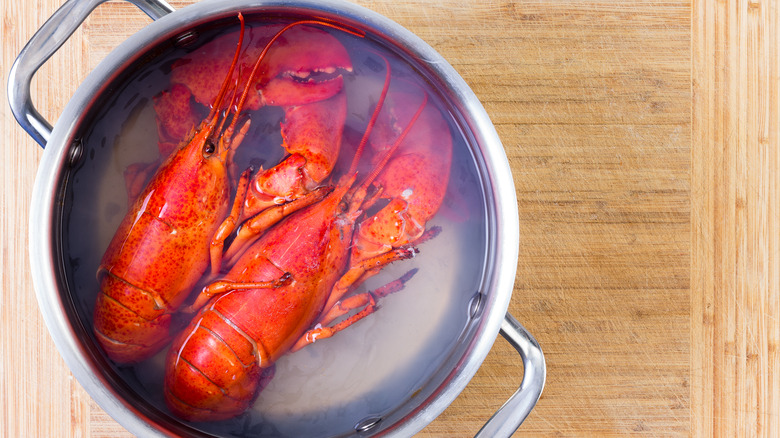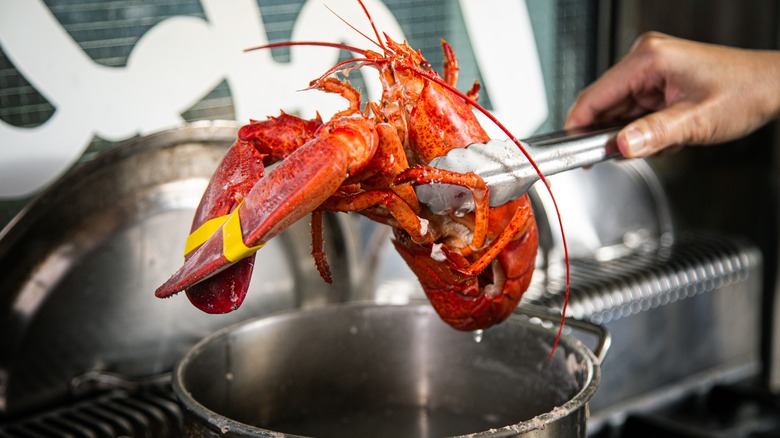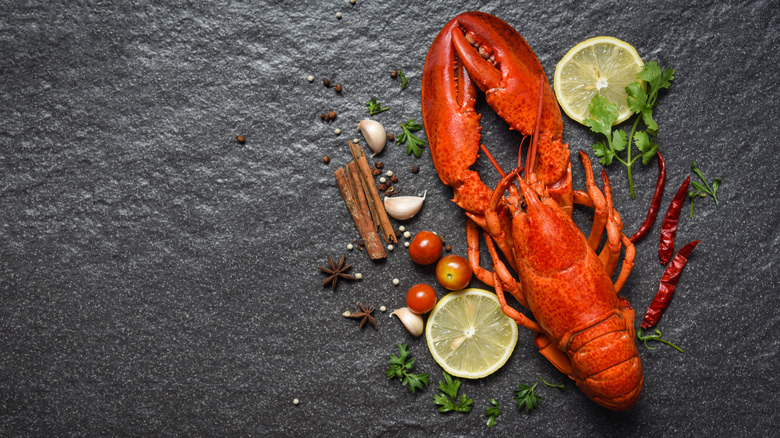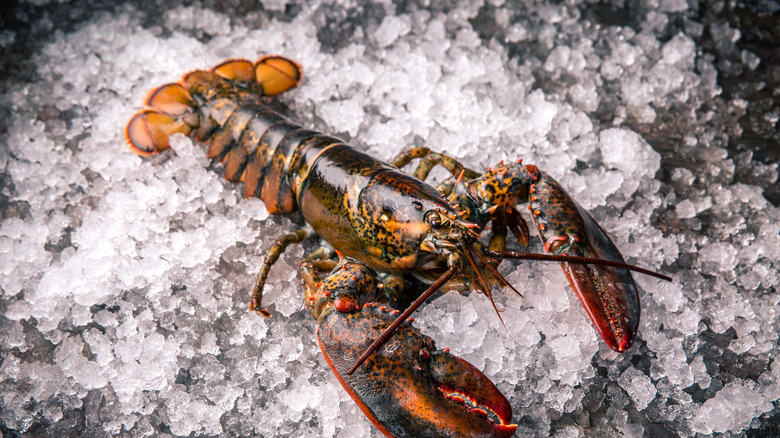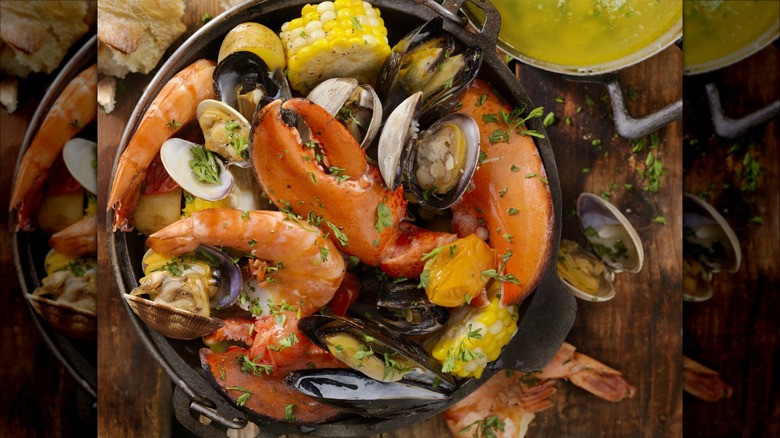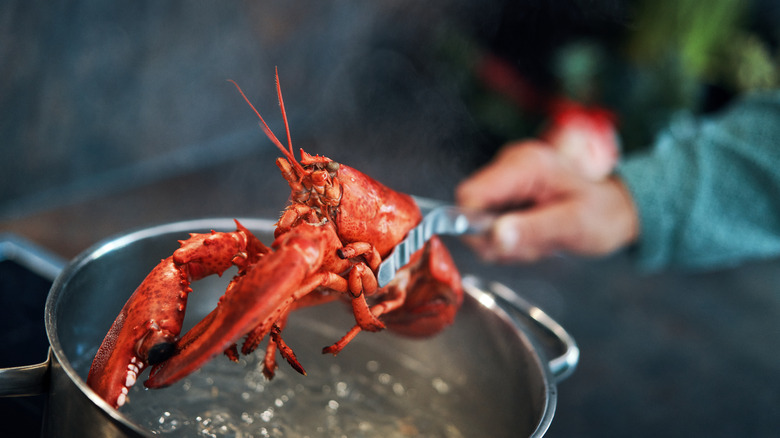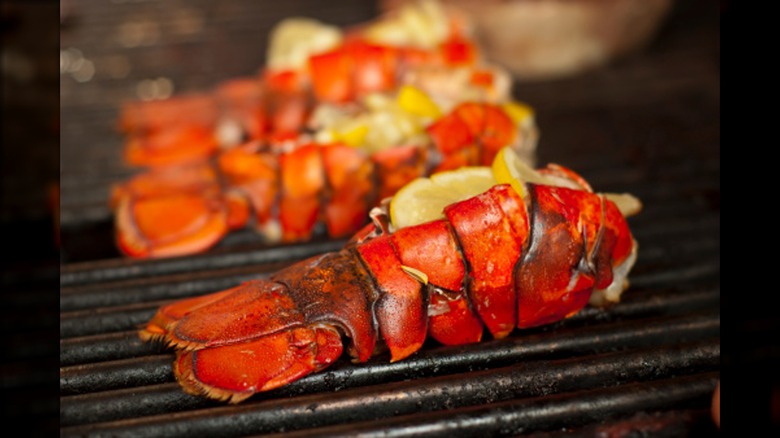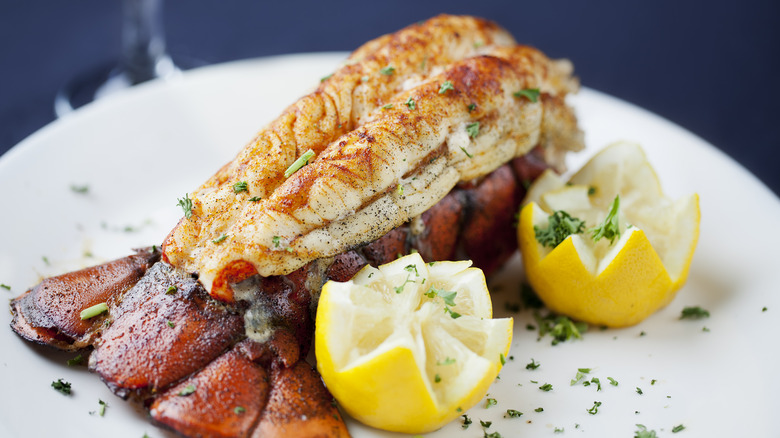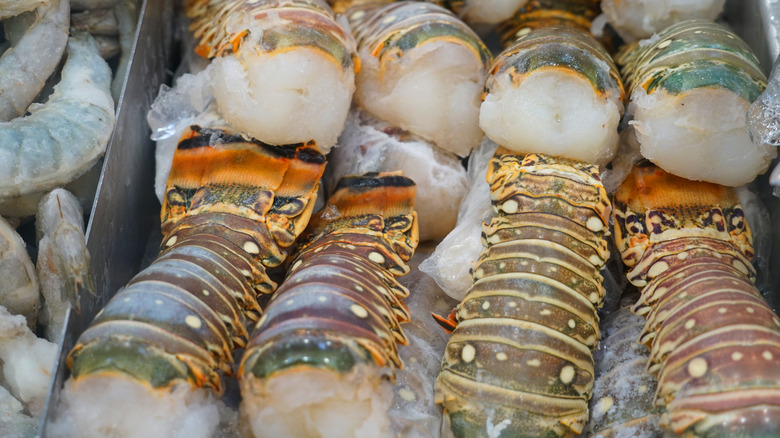11 Most Common Mistakes Everyone Makes Cooking Lobster
Lobsters are pricey, so if you're putting down that much money for what is considered a luxurious meal, you want it to taste right. However, cooking with lobsters can be quite tricky, and getting that restaurant-quality every time needs actual skill. If you've ever had a lobster fail, you might be confused about what step in the cooking process things went wrong.
A lot of preparation goes into cooking lobsters, from selecting the right ones at the seafood market to adequately seasoning them. These steps are crucial to determining how well your dish will turn out. Any mistakes along these lines could leave you with a plate of disappointment. If you want to master the skill of making perfect lobsters, you've got to keep reading. This article examines common mistakes people make when preparing lobsters, from buying the wrong kind to choosing the wrong cooking utensils. Plus, you'll find tips on achieving the desired flavor and texture.
1. Assuming that the biggest lobsters are the best
Giant lobsters at the fish market look so tempting. Who wouldn't want to pick up one of those big boys, especially if you're cooking to impress guests? After all, bigger lobsters mean more succulent flesh to feast on, right? Not quite. The truth is the biggest lobsters on the market are typically the oldest ones. But this isn't a good thing because it also means they will have tougher muscles. So, instead of enjoying lobster meat that dissolves on your tongue, you might struggle with flesh that's rubbery and hard to chew.
Another big issue with these monster lobsters is that cooking them can sometimes get complicated. Because they're so big, heat might not spread evenly to all the parts. So when you get it out of the pot, some bits might still be mushy while others are overdone.
When next you shop for this ocean delicacy, turn your eyes away from the biggest ones in stock. Go for medium-sized lobsters instead if you want to avoid all that hassle. Smaller lobsters tend to pack loads of flavor, and their muscles haven't turned hard yet. They're also much easier to handle in the kitchen. If you're looking for advice on the specific size of lobsters to purchase, consider sticking to those weighing about 1 and ¼ to 2 pounds. These are usually the best for optimal flavor and texture.
2. Thinking you can only cook whole lobster
Whole lobsters are like a gift that keeps giving because you can do so much with all the different parts. You get to enjoy the diversity of flavors and textures of the entire lobster as well. However, there's a misconception that you must slaughter and cook the whole thing yourself if you want to enjoy the best lobster dishes.
This false belief leaves people uncomfortable with boiling live lobsters in a tight fix. Thankfully, there's a way out – frozen lobster tails. Contrary to popular belief, these can also produce some of the most delicious meals. The beauty of cooking lobster tails is that even a newbie chef can work magic with them in the kitchen.
Another bonus to getting frozen lobster tails is that you can practice your cooking without as much pressure. These lobster pieces are relatively more affordable than a whole lobster, saving you money. If you don't reside close to the coast, it may be impossible to find fresh lobsters all the time. Buying frozen lobsters instead may be convenient as it allows you to enjoy these delicious seafood all year round.
3. Throwing away lobster shells
After cooking lobsters, discarding all the waste, including the shells, makes sense. These hard shells provided armor for the lobster while it was alive, but after cooking, it doesn't look like it serves any purpose. After all, it doesn't get soft upon cooking, and you can't chew on it.
The big surprise is that lobster shells are loaded with flavor, so they're not as useless as you might have thought. Therefore, instead of tossing them out just like that, you could harvest all that essence for your next dish. Start by cleaning the shells before placing them in a large pot of boiling water. Don't be shy to throw in some of your favorite seasonings and spices. Vegetables like onions, tomatoes, and celery also go into the pot.
Just like making bone broth, you let the mixture boil together for a while so that the rich flavor seeps into the water. Once it's done, you strain the stock, squeezing out every drop from the solid ingredients. You can immediately use this flavorful broth in any dish or store it in your freezer for later.
4. Putting too many lobsters in the pot
If you're cooking a lot of lobsters, maybe you have guests over, cramming as many as you can into the pot might seem like the way to go. But that might be the first step to a total kitchen disaster.
The problem arises because the heat won't spread evenly if you force too many lobsters to boil inside a small pot. The result: a mixture of overcooked, undercooked, and evenly cooked lobster pieces coming out of the same pot. To avoid this nightmare, you must ensure the lobsters have enough room in the pot and are entirely covered with water.
As a rule of thumb, don't try to force more than two lobsters into your regular-sized 4-quart pot. You'll need a bigger pot if you'd like to cook for a bigger crowd. For example, five to six lobsters need at least a 19 to 20-quart pot to cook uniformly. If you don't have such a large pot, it might be safer to just cook the lobsters in batches.
5. Seasoning the lobster with too many ingredients
Seasoning and spices are necessary to bring out the spark in your cooking. They create a beautiful blend of distinct notes, enhancing your dining pleasure. But with lobsters, flavors can quite easily get out of hand if you get it wrong.
The first step is knowing what spices pair well with lobster. Some cayenne pepper and paprika are excellent if you want to turn up the heat. This is a great way to balance out the natural sweetness of lobster meat. Basil, thyme, and fresh mint leaves add a minty flavor to the flesh. You can also experiment with classic spices like caraway, dill, rosemary, sage, and bay leaves.
However, you must be careful with how much of each ingredient you put in your food. The goal is to give the meat a hint of spice, so don't make the common seasoning mistake of using too much. Being heavy-handed during seasoning could bury the lobster meat's natural taste under too many complex flavors. At the end of the day, you'll have to use your discretion to get your desired flavor.
6. Storing the live lobster for too long
When you get live lobsters from the market, cooking them as quickly as possible is usually preferable. The best-tasting lobsters are usually the freshest ones. But the reality is that life sometimes gets in the way, and there are occasions when it may not be possible to cook the lobsters straight from the store.
In that case, you have the option of storing lobster for later. One way is to place the fresh lobsters in the refrigerator in a bowl and cover it with a wet cloth. Alternatively, you can use seaweed to cover the container. You should place this container on ice or in your refrigerator. But keep in mind, it only lasts about two days. Any longer than that is not advisable.
Now, if you need more time, consider freezing the lobsters. Just boil them for approximately five minutes and take them out. Proceed to remove the shells, pack the flesh in aluminum foil, and place that in the freezer. This way, you can keep the lobster for much longer periods, up to six months.
7. Boiling lobster and vegetables in the wrong order
For the classic lobster boil, you'll need lots of vegetables and different kinds of seafood. Just boiling all of them together in a large pot seems easy enough. It's impossible to mess that up, too, right? Well, putting everything in the pot in the wrong order could change your results.
You typically start cooking lobster by placing it in a pot of salted boiling water. However, for a lobster boil, things are a little different. Instead, the veggies have to go in the water first. Allowing the vegetables to cook first in plain water helps them retain their authentic flavor without the lobsters interfering.
After a bit, the lobsters go into the pot. Allow them to cook before adding any other type of seafood you'd like to cook. Keep your pot on heat for anywhere between 15 to 25 minutes so that everything is thoroughly cooked. Don't forget to add all your favorite herbs and spices along the way.
8. Forgetting to drain after cooking
Have you ever cracked open a lobster shell on your plate only to be greeted by a flood of salt water gushing out? That's the sort of thing that happens when you forget to drain lobsters after cooking. If you didn't know, lobster shells aren't perfectly sealed. In fact, there is lots of room between the shells and flesh. This means that as the lobster sits in the pot, water creeps in through the cracks and accumulates in the crevices between the shells and meat.
The only way to get around this problem is to drain the lobsters immediately after cooking. An easy way to do this is to drill two holes with your cooking knife on the tip of each claw or between the lobster's eyes. Then, you hold it upside down till all the water drips out. Next, pat your lobsters dry and prepare to serve.
9. Thinking that boiling is the only way to cook lobster
Lobsters are a lot more versatile than you think. Although boiling and steaming are the most popular ways to prepare them, you have so many other options. The best part about preparing lobsters is that it takes little time, no matter what cooking method you choose.
You could miss out on a new world of delicious meals if you've never tried grilled lobsters. It's straightforward to prepare. Just start by parboiling some lobsters. Cut open the shell to harvest the flesh. Cover it in melted butter and your favorite spices. Place this on the grill and watch as the meat toughens up. Grill each side for about five to six minutes, and your lobster is ready to eat. One of the best grilling tips you should note is to ensure your grill is super hot before you start, as this helps keep your meat soft and moist.
Baked lobster tails are just as delicious, and you can try them by following these simple instructions. Heat the oven to approximately 400 F and place your seasoned lobster tails. Ten minutes later, you'll have perfectly cooked lobsters on your plate. You can also use an air fryer to cook your lobsters at 350 F for about seven minutes instead.
10. Overcooking or undercooking the lobster meat
Your lobster may be undercooked if you don't cook it at the right temperature or if you don't cook it for long enough. You can always tell if your lobster is undercooked just by its appearance. Uncooked lobsters have the characteristic greenish-black shells and turn bright orange when cooked as heat denatures the shell proteins. If your lobster shell still has spots of green or black, it might be undercooked.
Undercooked lobsters also have pinkish or translucent flesh that feels mushy. It also won't taste very good and could be dangerous to eat. Undercooked lobsters are a great hiding place for microorganisms that cause food poisoning. Lobster poisoning can cause symptoms like nausea, vomiting, diarrhea, fever, and confusion.
At the other end of the spectrum is overcooked lobsters. Cooking lobsters at higher temperatures and for longer durations causes them to become overdone. The texture becomes rubbery and hard. Grab yourself a meat thermometer to avoid overcooked and undercooked lobsters. It's generally advisable to cook lobsters at 140°F for 9 to 12 minutes. You may need to cook hard shell lobsters for a longer time.
11. Cooking frozen lobster directly
Technically, you can cook frozen seafood straight from the pack without needing to thaw it first. All you need to do is increase the cooking time so that it gets fully cooked. And although you could do the same for frozen lobster tails, you won't get the best results. Cooking frozen lobster tails without defrosting is more likely to produce tough meat.
The best way to prepare frozen lobster is to thaw it first. Start by placing it in your refrigerator for a couple of hours. You can put it in the refrigerator the night before so that you can start the morning with fully defrosted lobster tails ready for cooking.
If you don't have that much time to spare, you could place the lobster tails in a plastic bag in cold water. The plastic bag is essential to keep water from entering the cut end of the tail, leaving you with a soggy mess. Once you've successfully melted off all the ice, you can now cook your lobster.
